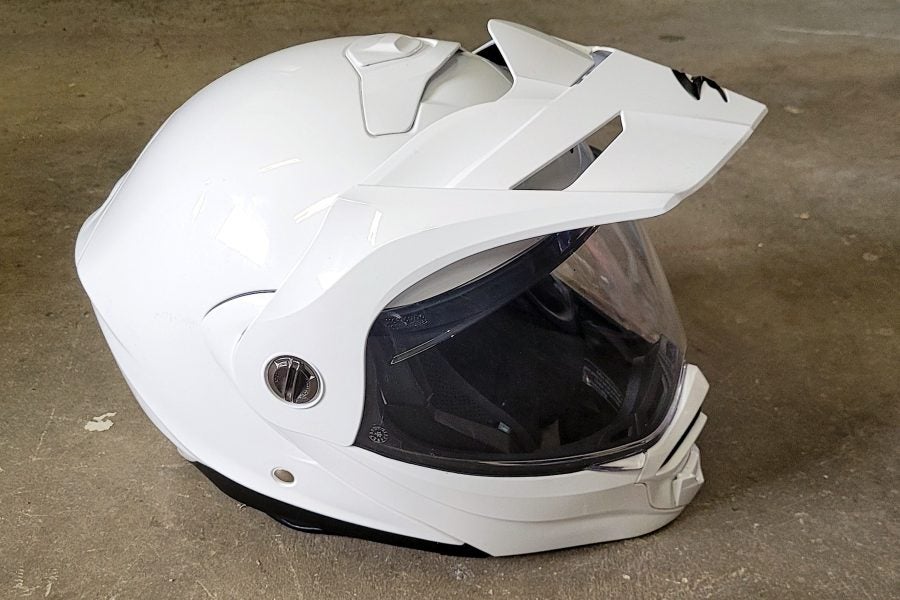It’s an obvious thing to say, but different people like different things, and that guides their choices as consumers. Some people like gear with trick technical features—”Lightest helmet on the market!” or “Most peripheral vision in a full-face helmet!”. Other people just want a flashy graphic. Others want safety, others want airflow. You get the idea.
What if you want a collection of useful features, but you don’t have enough money or space for a shelf full of helmets? Once again, Scorpion-EXO tackles this question. The new Scorpion-EXO AT960 helmet offers modular capability in a full-face adventure-style helmet that changes to a standard streetbike orientation with only a couple of minutes of work. They sent me one to try this year—here are some thoughts after months of use.
The technical details
The Scorpion-EXO AT960 debuted earlier in 2023 as a replacement for the AT950, which held similar features. Why the upgrade? Changing helmet safety regulations in Europe along with a new option for Scorpion-EXO’s built-in communicator system, that’s why. The 960 is a lot like the 950, but it meets the new EU standards and is legal for sale there going forward from 2024, when the continent changes to ECE 22.06 standard (in Europe, the AT960 is the ADX-2, replacing the ADX-1, which was equivalent to the 950).
The AT960 has a polycarbonate shell with EPS liner, very old-school stuff. There are three shell sizes, so if you have a size Small head, you’re not wearing a size Large shell—this cuts weight, a bit. However, the AT960 is still a bit heavy, at 4.09 lb for a Medium helmet.

I opted for plain white paint, as always, but Scorpion-EXO offers the AT960 in some pretty trick graphics options. Photo: Scorpion-EXO
This is the cost you must pay for adding such features as an ADV-style peak, a drop-down sun shield and a locking flip-front. Is 4 lb still too much, especially considering the previous AT950 was lighter? Take note that Schuberth’s much-more-expensive E2 helmet, which boasts the same features is only roughly a quarter-pound lighter at well over twice the price (the Schuberth is $799, while the AT960 starts around $280—current pricing is here at Revzilla).
The KwikFit cheekpads are now configured to fit eyeglasses (the old 950 didn’t do well in this regard). You can wear goggles with this helmet, and you can remove the fog-treated eyeshield as well as the ADV peak, with the use of screw-type fasteners on the side. In other words: You can turn the AT960 into a wide-open dirt-style helmet, or strip it down to look like every other street helmet.
There’s a port on the left-hand side of the helmet, to fit the EXO-COM comm set (about $190 if purchased separately). This makes for a much more streamlined installation than your standard clamp-on Cardo/Sena/Uclear/Whatever, but some people are unhappy, saying the positioning of the EXO-COM port combined with the sliding lever that lowers the internal sunshield means you can’t mount a standard comm set to the side. In my case, I just stuck a Cardo on the port’s cover, and have had no problems yet this year.

With the peak removed, the AT960 becomes a decent street helmet. Note the EXO-COM installed on the side of the helmet, with blue LED lit up. Photo: Scorpion-EXO
The AT960 fits an intermediate oval-shaped head. There’s a wide variety of paint, if you want a flashy look.
On street and trail
I put down quite a few miles with the AT960 this year, mostly on the street but also in the dirt. The TL/DR is that this helmet does everything you need at a very affordable cost, even if it’s not some expensive brand-name product.
I don’t notice the weight when I’m on the trails. The flip-front feature is very convenient when street-touring, or even when pulling over to grab a snack, drink, or talk to others in the woods. And even if the AT960 is not super-quiet, it’s quiet enough to tour all day without suffering from tinnitus all night (wear your earplugs, of course!). This is more than can be said for many budget helmets!

Another angle of the EXO-COM installed on the side of the helmet. Note its low profile, on the rear left side. Photo: Scorpion-EXO
The airflow from the dual chin vents (one closable, one isn’t closable) is pretty good, but if you want lots of breathing capacity and a fog-free faceshield, you’re best-off flipping the shield up. It can be closed over goggles, a question that many dual sport riders want to know, but it doesn’t work particularly smoothly. If you were going to ride long miles with this helmet in “dirt” configuration, you’d probably be happiest if you removed the faceshield.
When you do that, be very careful. There’s an oddly-shaped nylon washer that fits under the retention screw on each side, and these are easy to lose if you’re not watching out for them. I lost mine for a while (eventually found it) and other users on ADVrider complained about the same thing. But aside from that, it’s a simple process; you can use a large coin to engage the slot in the screw head, and do the changeover in about two minutes.
Of course, it’s just as easy to remove the helmet’s ADV peak this way, converting it to “street” configuration. Let’s be honest—this is where most users of this helmet will spend most of their miles, as most enduroheads are going for an off-road helmet to start with. The conversion with the AT960 is easy either way, and I like that, because it offers versatility on the road. Riding to a rally for long street miles, then going to hit the dirt while you’re there? It’s a quick job to remove the peak for the four-lane slog, then re-install it for the trails, and reverse the procedure for the trip home. Or maybe you’re riding off-road with the faceshield removed, but it starts to rain? If you’ve got the shield stowed somewhere on your bike, it’s quick to pull over and re-install. And with the simple screw-type fasteners, there’s little to go wrong.

In my case, I used a sticky mount to install the Cardo on top of the trapdoor of the EXO-COM compartment. So far, I’ve had no trouble with this arrangement after a riding season’s usage. Photo: Zac Kurylyk
This is important if you’re on a longer trip, because I’ve seen trick faceshield fasteners fail on expensive helmets. What are you going to do when your faceshield retention mechanism fails on your pricey Euro-built or Japanese-built helmet on the Dempster? Parts are days/weeks and thousands of miles away… with the AT960, you can figure out a bodge fix with stuff from a hardware store.
However, as a counterpoint: The screw-type fasteners seem to be susceptible to long-term loosening if installed carelessly or if the helmet’s ADV peak vibrates a lot in the wind. I didn’t find the peak caught too much wind, except for one instance of a strong coastal crosswind, but other users complained about the peak being too floppy, which caused the fasteners to back out.
I think this is something that’s easily avoided, although some weather and some bike windshields will exacerbate the issue. Just keep an eye on it; it’s an easy problem to avoid, if you’re watching out for it.

One thing to watch out for: Make sure those screws on the faceshield/peak assembly don’t loosen off, or you may lose the assembly at speed! You should notice the warning signs of this (difficulty in opening the helmet) long before it happens. Just pay attention! Photo: Zac Kurylyk
The summary
I think this helmet offers a lot of capability for a reasonable price. I have other helmets that are quieter, or flow more air, or with other advantages, and when I need those features, I wear those helmets. But if I need a helmet that does everything, the AT960 is the way to go, and I expect to continue using it regularly in the years to come. It’s easily found for under $300 in the US and less than $400 in Canada, and comes with a five-year warranty to boot. That’s pretty good value, and I expect many customers will at least consider this option in the coming years, as riders are increasingly strapped for cash due to the weakening economy.







